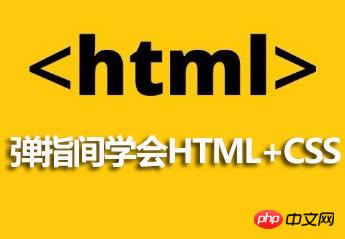Home >Web Front-end >CSS Tutorial >Summary of various cascading style examples in css
Summary of various cascading style examples in css
- 伊谢尔伦Original
- 2017-06-07 14:55:571619browse
CSS (Cascading Style Sheets) is used to specify the presentation form of HTML documents. Everything has a sequence, everything has a seniority. Under normal circumstances, no differences can be seen, which is the so-called equality of all living beings. However, when conflicts and entanglements occur, it is obvious that it is impossible to achieve complete equivalence, and the identity differences will appear in order. Cascading is the process in which the browser stacks multiple style sources and ultimately determines the result. This article is going to talk about the specific role of CSS cascading styles.
First of all, you can learn free courses related to php Chinese website
1. Learn"Learn HTML+CSS at your fingertips"中的CSS cascading Tutorial
##css cascading style
1.CSS style inheritance and cascading
Features:tag selector will select all specified tags in the current page; tag The selector has no relation to the current tag hierarchy of the code and can be selected as long as it is on the current page.
id selection: You need to specify a tag to set the id value first (the id value cannot be repeated and is unique in the entire page).Class selection: Give the label a class name and select the specified label through the class selector.
2.Detailed explanation of CSS cascading mechanism
Cascading in cascading style sheets means that styles will be passed from one level to another in the document structure. Its function is to let the browser decide which source among many sources to apply style attributes to a certain tag. Cascading is a powerful mechanism. Understanding cascades can help you write CSS in the most economical and maintainable way, and can help you create the ideal document look you want. 3.Detailed explanation of CSS inheritance and cascading features
The first P does not use a selector, so the default display color of HTML (black) is usedThe second P uses a class selector, so the color of the class selector (red) is preferred The third P uses two selectors, ID and class. Due to the priority of the ID selector Higher than the class selector, so the color is displayed in blueThe fourth P uses an inline selector and an ID selector. Since the inline selector has a higher priority than the ID selector, the color is displayed in yellowThe fifth P uses two class selectors at the same time. When the browser interprets the web page, the color defined by the first class selector shall prevail, so the color is displayed as purpleThe sixth one Personal P uses two ID selectors at the same time, but since the ID selector can only be used for one tag at the same time and is globally unique, the browser considers this to be illegal, and the color is displayed at its default value (black) 4.Detailed description of CSS cascading style sheet
[attribute] Select elements with attribute attributes. [attribute=value] Select elements with attribute attribute and attribute value equal to value. [attribute~=value] Select an element that has an attribute attribute and the attribute value is a space-separated list of words, one of which is equal to value. [attribute|=value] Selects the E element that has the att attribute and the attribute value is a string starting with val and separated by the connector "-". [attibute^=value] Matches E elements that have attribute attributes and whose values start with value [attribute$=value] matches E elements that have attribute attributes and whose values end with value [attribute*=value] Matches E elements with attribute attributes and values containing value5.Analyze the value of CSS style sheets, inheritance, cascading and attributes
CSS has properties that control basic formatting (such as font-size and color, etc.), properties that control layout (such as position and float, etc.), and also determines where visitors will change pages when printing. Print control elements. In addition, there are many other attributes.The style sheet contains rules that define the appearance of the web page. Each rule has two main parts: selector (selection) and declaration block (declaration). Selectors determine which elements are affected, and declaration blocks consist of one or more attribute-value pairs that specify what should be done.
CSS specificity, inheritance and cascading
The declaration marked !important is called an important declaration. It has no speciality, but it must be compared with the non-important declaration. Consider them separately.Specifically: non-important statements are grouped into a group, and conflicts between them are resolved using specificity; important statements are grouped into a group, and conflicts between them are resolved internally; important statements always take precedence over non-important statements.
Related Questions and Answers
[Related recommendations]
1. PHP Chinese website free video tutorial: "php.cn Dugu Jiujian (2) - css video tutorial"
2. PHP Chinese website related articles: CSS Let DIV Overlap Example Summary
The above is the detailed content of Summary of various cascading style examples in css. For more information, please follow other related articles on the PHP Chinese website!


